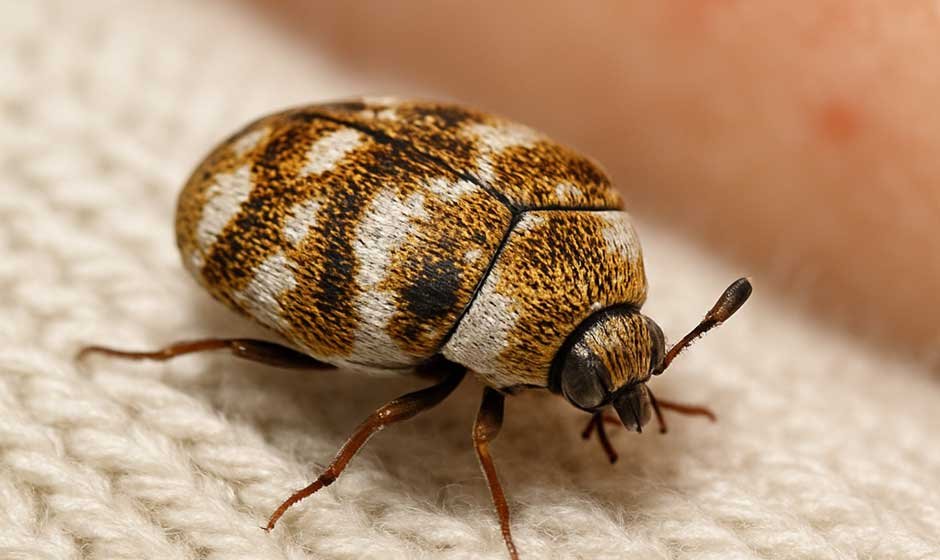That sudden, inexplicable itch or those mysterious red bumps on your skin can be quite unsettling. Often, our minds jump to the usual suspects: insect bites. And when these irritations appear indoors, carpet beetles frequently come to mind. However, the idea of “carpet beetle bites” is a widespread misunderstanding. Getting to the bottom of what’s truly causing these reactions is the first crucial step towards finding relief and managing the situation effectively.
Table of Contents
ToggleDo Carpet Beetles Really Bite?
Let’s clear up a common misconception right away: adult carpet beetles do not bite humans. These tiny insects are far more interested in the natural fibers of your carpets, clothing, and upholstery, or even stored food items and animal-derived materials, than they are in human blood. Their mouthparts are designed for munching on these substances, not for piercing skin. So, if you’re dealing with an unexplained rash, it’s highly improbable that an adult carpet beetle is the culprit.
The actual source of skin irritation isn’t the adult beetle at all, but rather their larvae. These small, worm-like creatures are covered in fine, bristly hairs, known as setae. When these larvae or their shed skins and airborne hairs come into contact with human skin, they can trigger an allergic reaction. This reaction often looks and feels like bites, which is why the confusion is so common.
What Causes the “Bite-Like” Reaction?
The skin irritation linked to carpet beetles is medically referred to as Carpet Beetle Dermatitis. This condition is essentially an allergic response to those microscopic, barbed hairs (setae) found on the larvae. These tiny hairs can easily break off and embed themselves in your skin, acting as irritants. For individuals with sensitive skin or those prone to allergies, this contact can provoke a noticeable immune system reaction.
Your body’s immune system mistakenly identifies these larval hairs as harmful invaders, prompting the release of histamines and other inflammatory chemicals. This biological chain reaction leads to the classic symptoms of an allergic response: redness, swelling, and intense itching. It’s vital to remember this is a form of contact dermatitis, not a direct bite, and the severity of the reaction can differ significantly from one person to another.
Identifying a Carpet Beetle Rash: Key Symptoms
Learning to recognize the specific characteristics of a carpet beetle rash can be incredibly helpful in distinguishing it from other skin conditions or insect bites. Symptoms typically appear relatively soon after exposure to the larval hairs, though sometimes a delayed reaction can occur.
Appearance of the Rash
The rash frequently manifests as small, red, itchy bumps or welts, which might easily be mistaken for mosquito bites or hives. In some instances, a more widespread, diffuse rash can develop, especially on body areas that have had prolonged contact with infested items like bedding or clothing. These lesions can show up anywhere, but are commonly seen on exposed skin such as arms, legs, neck, and torso. You might even notice a tiny, raised center in the bumps, which could be an embedded hair.
Sensation and Duration
The most prominent sensation associated with carpet beetle dermatitis is an intense itch, ranging from a minor annoyance to severe, persistent discomfort. This itching can be particularly disruptive at night, making sleep difficult. The rash’s duration varies; without further exposure, symptoms might fade within a few days to a week. However, if exposure continues, the rash can linger, worsen, and even lead to secondary skin infections from scratching. Repeated contact can also heighten sensitivity, leading to more severe reactions over time.
Carpet Beetle Rash vs. Bed Bug Bites: How to Tell the Difference
Distinguishing between a carpet beetle rash and bed bug bites is crucial for both effective treatment and successful pest control. While both can cause similar-looking skin reactions, there are clear differences to look for.
Bite Marks vs. Rash
Bed bug bites typically appear as small, red, itchy welts, often arranged in a distinctive linear pattern (sometimes called “breakfast, lunch, and dinner”) or in clusters. They usually show up on skin exposed during sleep. In contrast, a carpet beetle rash is generally more spread out and less patterned. It tends to be an overall irritated area rather than distinct, isolated bite marks. A carpet beetle rash might occasionally reveal a central red dot or a tiny hair, which is usually absent in bed bug bites.
Other Signs of Infestation
Beyond skin reactions, other clues can help pinpoint the culprit. For bed bugs, keep an eye out for small blood spots on sheets, tiny black fecal spots on mattresses or furniture, and shed bed bug skins. A faint, musty odor might also indicate a severe infestation. For carpet beetles, meticulously inspect natural fiber items like wool carpets, upholstered furniture, clothing, and furs for damage. You might also discover shed larval skins, which resemble tiny, translucent husks, in hidden spots such as under furniture, along baseboards, or inside closets. Small, irregular holes in fabrics are another classic sign of carpet beetle activity.
How to Treat a Carpet Beetle Rash
Managing a carpet beetle rash involves two main steps: alleviating the symptoms and, most importantly, eliminating the source of the irritation. Taking prompt action can prevent the rash from worsening and recurring.
At-Home Remedies
For mild to moderate reactions, several home remedies can offer relief. Start by gently washing the affected skin area with mild soap and cool water to remove any lingering larval hairs. Applying an over-the-counter hydrocortisone cream (0.5% or 1%) can effectively reduce inflammation and itching. Calamine lotion or antihistamine creams are also good options for soothing the skin. A cool compress applied to itchy areas can provide temporary comfort. Remember to avoid scratching, as this can break the skin and potentially lead to secondary bacterial infections.
When to See a Doctor
While most carpet beetle rashes are not serious, it’s wise to consult a doctor if the rash is severe, spreading rapidly, or shows signs of infection. These signs include increased redness, warmth, pus, or a fever. A healthcare professional can offer an accurate diagnosis, prescribe stronger topical corticosteroids, oral antihistamines, or, in rare cases, antibiotics if a secondary infection has developed. Anyone experiencing difficulty breathing or severe swelling should seek immediate medical attention, as these could indicate a more serious allergic reaction.
Preventing Future Reactions: Getting Rid of Carpet Beetles
The most effective strategy for preventing future carpet beetle rashes is to completely eliminate the source of the infestation. This demands a thorough and systematic approach to cleaning and pest control.
Inspection and Cleaning
Begin with a meticulous inspection of your home, paying close attention to areas containing natural fibers. This includes carpets, rugs, upholstered furniture, curtains, closets, and stored clothing. Vacuum all carpets, rugs, and furniture thoroughly, focusing on edges, cracks, and crevices where larvae often hide. Immediately dispose of the vacuum bag after use to prevent re-infestation. Launder or dry-clean all infested clothing, bedding, linens, and other washable items, using hot water whenever possible. Steam cleaning carpets and upholstery can also be highly effective in killing both larvae and eggs.
Eliminating the Source
Identify and remove any potential food sources for carpet beetles. This might involve old woolens, furs, feathers, accumulated pet hair, dried food spills, or even insect and animal carcasses in attics or wall voids. Store any susceptible items in airtight containers. For severe or persistent infestations, it is highly recommended to contact a professional pest control service. They possess the expertise to accurately identify the species, locate hidden breeding sites, and apply appropriate treatments to safely and effectively eradicate the beetles. Regular cleaning and constant vigilance are your best tools for maintaining a carpet beetle-free environment.
Conclusion: Stay Vigilant and Itch-Free
To sum it up, while the phrase “carpet beetle bites” is a misnomer, the discomfort these pests cause is undeniably real. The itchy rashes are not true bites but rather allergic reactions to the bristly hairs of carpet beetle larvae. Grasping this distinction is fundamental for correct identification and management. By understanding the symptoms, differentiating them from other insect bites, and implementing comprehensive cleaning and pest control measures, you can effectively prevent and treat carpet beetle dermatitis. Staying proactive with household cleanliness and promptly addressing any signs of infestation will help ensure you enjoy an itch-free and comfortable living environment.













